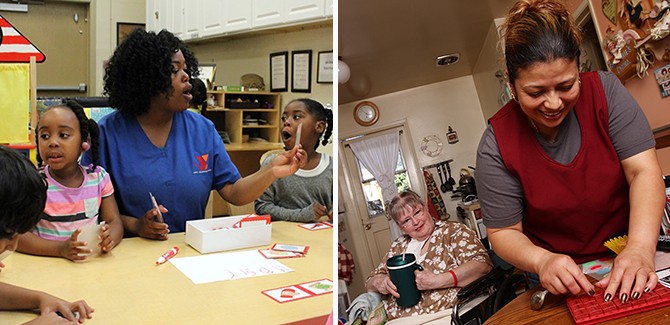We are proud to announce the launch of the CREATIVE CARE COUNCIL! LEARN MORE
We are proud to announce the launch of the CREATIVE CARE COUNCIL! LEARN MORE

This article first appeared on Medium. Read the original there.
If you have children, you have likely struggled to find affordable quality childcare. Many of us face the same struggle seeking home care for a loved one or ourselves. In both cases costs to consumers are often out of reach while wages for workers are too low to retain a trained, stable workforce. Ballot initiatives this year in Alameda County California and Maine would make important steps towards making these essential care services affordable and accessible.
In Alameda County, a ballot initiative this June would provide funding to expand the number of early child education scholarships, while raising the wage floor for workers. Today, childcare subsidies are available only to those in the lowest income groups, while funding is insufficient to reach more than fraction of those who qualify, resulting in long waiting lists. New research evidence finds that the first five years of life are central to brain development, yet early childhood education remains chronically underfunded.
The Alameda County initiative would both increase the number of scholarships for low- and moderate- income children and set a minimum wage standards for centers who make use of the scholarships. While the ballot measure explicitly states that the entry-level wage will be at least $15 an hour, a task force was created to develop recommendations for a wage scale for workers with higher levels of training and experience (which I have the honor to serve on).
In Maine, a coalition of state organizations led by Maine People’s Alliance and Caring Across Generations filed an initiative for the November election that will fund universal long term care for residents of that state. If approved by voters, the program would provide homecare for more than 10,000 seniors and individuals with a disability, increase wages for workers, and provide training to professionalize homecare work. The program would be funded through a tax on income exceeding the maximum wages subject to Social Security payroll taxes (currently $127,000 a year).
According to a new report from my colleagues and I at the University of California, Berkeley and the University of Wisconsin, Madison, the median hourly wage for early care and education and homecare workers together was just $10.29 an hour nationally in 2016. Few of the workers in these industries have job-based coverage. And while these are some of the fastest growing occupations in the economy, their inflation-adjusted wages have been stagnant over the past decade. Moreover, the workforce is disproportionately women of color and immigrants. Nearly half of the workers are in families that rely on one more social safety net program to make ends meet.
Investing in the early care and education homecare workforces is essential for quality of care. Workers who are better paid stay in jobs longer and are less stressed. As a result, they form stronger relationships with those they care for and make stronger contributions to their health and development. The gains from high-quality early care and education experiences are borne out over a child’s lifetime in better school, health, and economic outcomes, and lessening the need for other social interventions. More and better care for seniors and people living with disabilities improves health outcomes and allows individuals to remain in their homes rather than moving into more costly nursing homes.
Availability of quality childcare and homecare is important for the economy as a whole. It allows mothers and other non-paid care givers to participate in the labor market. The availability of high-quality and reliable early care and education increases worker productivity, decreases absenteeism, and reduces turnover among parents in the labor force.
Investing in care promotes equity. Women, and in particular women of color, are disproportionately represented in poorly-paid care work, so improving the quality of homecare and early care and education jobs shrinks the earnings gap between men and women, as well as the race gap among women.
There is a big debate in the country about the effects of technology and automation on jobs. One thing is clear, care-giving jobs are here to stay and the need is growing. The aging of the baby-boomers and longer life-spans is increasing the demand for home care workers — while low-wages and the lack of benefits is creating a shortage of workers. With consumers already stretched to the limit, the only workable solutions on both ends of the life cycle will require a significant public investment to expand access to childcare and homecare services and improve the quality of jobs. Voters on opposite sides of the country in Alameda County California and the state of Maine have the opportunity to take a step forward in addressing these vital issues. The rest of us should learn from their examples.